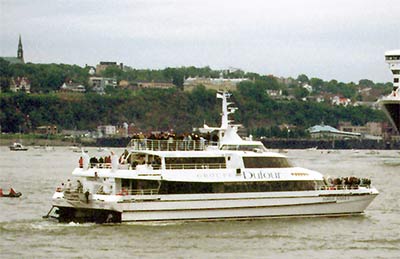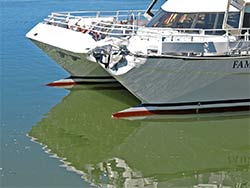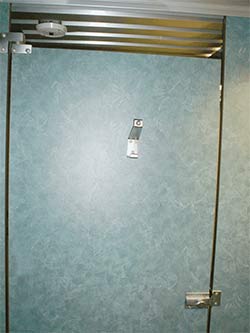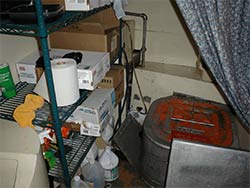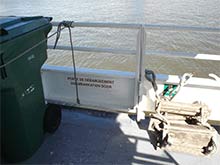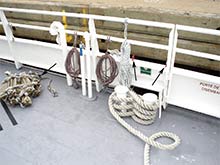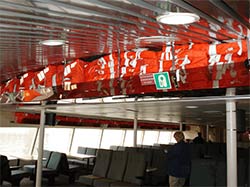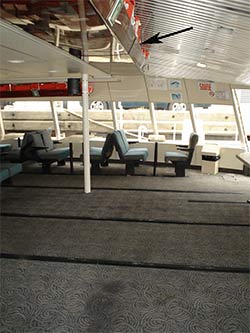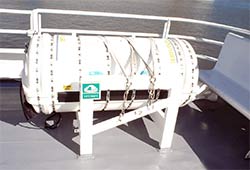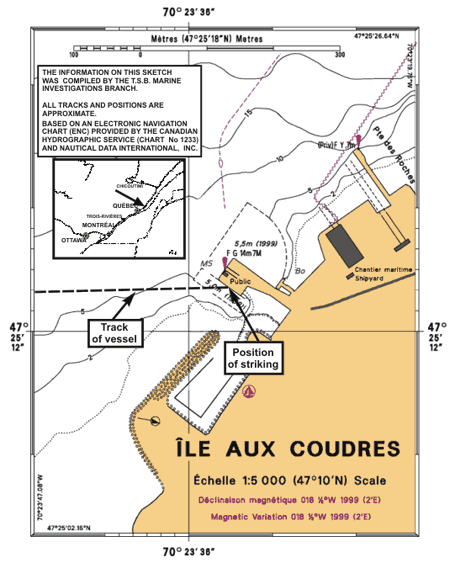Striking of wharf
High-speed passenger catamaran
Famille Dufour II
Public wharf, île aux Coudres, Quebec
24 August 2004
The Transportation Safety Board of Canada (TSB) investigated this occurrence for the purpose of advancing transportation safety. It is not the function of the Board to assign fault or determine civil or criminal liability. This report is not created for use in the context of legal, disciplinary or other proceedings. See Ownership and use of content. Masculine pronouns and position titles may be used to signify all genders to comply with the Canadian Transportation Accident Investigation and Safety Board Act (S.C. 1989, c. 3).
Summary
At approximately 0930 on 24 August 2004, in clear and calm conditions, the high-speed passenger catamaran Famille Dufour II, with 159 passengers on board, struck the southwest side of the public wharf at île aux Coudres at a speed of 8.7 knots. The force of the striking caused injuries to nine passengers and one crew member, and the vessel sustained hull damage on the port side forward.
Factual information
Particulars of the vessel
| Name | FAMILLE DUFOUR II |
|---|---|
| Official number | 815649 |
| Port of registry | Québec, Quebec |
| Flag | Canada |
| Type | High-speed passenger catamaran |
| Gross tonnageFootnote 1 | 465 |
| LengthFootnote 2 | 36.61 m |
| Draught | Forward: 2.5 m Aft: 2.5 m |
| Built | 1994, île aux Coudres, Quebec |
| Propulsion | 2 Hamilton Waterjets, 4176 kW, 30 knots |
| Crew | On board: 15 Minimum: 10 |
| Passengers | On board: 159 Maximum: 340 |
| Operator | Groupe Dufour |
| Owner | La Goélette Marie-Clarisse Inc. |
Description of the vessel
The vessel is a carvel-flush built, aluminum-hulled high-speed passenger catamaran, propelled by two water jets (see Photo 1). It is highly manoeuvrable and has a service speed of 30 knots.
The main and upper decks are fitted with forward- and aft-facing seats and tables for the use of the passengers. An open-air observation deck is located above the upper deck just aft of the navigating bridge, and similar open deck areas for passengers are provided at the bow and stern.
The bridge layout is typical of a high-speed vessel and includes two seats; the vessel master normally occupies the starboard seat, the first officer, the port-side seat. Manoeuvring and navigation-related instrumentation is arrayed below window level across the fore part of the bridge. Dual-control levers for the propulsion system are in a centre console between the two seats. Helm commands are provided by a joystick located on the starboard arm rest of the master's seat. Navigation instrumentation consists of radar, gyro compass, global positioning system, depth finder, and two electronic chart systems.
The vessel operates primarily between Québec, île aux Coudres, and Tadoussac, Quebec, providing day and evening cruises and whale-watching excursions during the summer navigation season. The vessel also provides transportation for guests staying at the operator-owned hotels at île aux Coudres and Tadoussac.
History of the voyage
At approximately 0730 eastern daylight timeFootnote 3 on 24 August 2004, the Famille Dufour II departed Québec bound for île aux Coudres and Tadoussac. On board were 159 passengers and 15 crew members, including a naturalist to act as a guide for the passengers during the voyage. The bridge team consisted of the master, an observing master, and the first officer.
At the start of the voyage, the naturalist, as part of his duties, briefed the passengers over the public address system on the vessel's life-saving equipment. The vessel proceeded at a cruising speed of 25 to 30 knots along its intended route toward île aux Coudres. The master had the con of the vessel and the voyage went without incident.
At about 0915, the vessel approached the public wharf on the north side of île aux Coudres, and the first officer left the bridge to prepare for berthing operations. The master was in control of the vessel, and the observing master occupied the port-side seat, a position from which most controls are easily accessible. Approximately 5 to 10 minutes before arrival, the naturalist announced over the public address system that passengers departing the vessel at île aux Coudres would be doing so shortly.
Weather conditions were good with clear visibility, light winds, and calm seas. The tide was flooding, and high tide was predicted to occur at approximately 1224.
Although the vessel's speed was reduced as it neared the wharf, the first officer observed that the speed was faster than normal for berthing operations. He then alerted the bridge by hand held radio that the speed of approach was too fast. As the vessel continued toward the wharf without any further reduction in speed, the first officer made two more radio calls to the bridge. The observing master heard one of the radio calls and made a remark to the master about the excessive speed of approach. None of the calls were acknowledged by the master.
At approximately 0930, the vessel struck the southwest face of the public wharf at a speed of 8.7 knots and at an approach angle of about 37 degrees. The port corner of the bow and the port hull at the waterline sustained damage (see Photo 2).
When the vessel struck the wharf, passengers were either in their seats or moving around the main and upper decks. Some passengers were using the stairway. The nine passengers and one crew member who sustained injuries were not seated at the time. Their injuries were due to either falling on deck or against an object. One of the injured passengers fell in the stairway.
After the vessel was brought alongside, the first officer noticed that the stern was pulling away from the wharf and he went up to the bridge to investigate the cause. On his way, he had a crew member make an announcement over the public address system requesting assistance from passengers with medical experience. One of the passengers, an orderly, came to the aid of the injured passengers.
When the first officer arrived on the bridge, no one was there, and he proceeded to check the position of the port and starboard single-lever controls. The port control was in the idle reverse position and the starboard control, in the idle forward position, which caused the vessel to turn. Consequently, he set both controls to the zero speed position. The engine speeds and the position of the split-duct reverse deflectors are both controlled by the single-lever controls. When they are in the zero speed position, the engine speed demand is at a fixed minimum (about eight per cent of maximum speed) and the reverse deflectors are positioned to generate zero forward thrust; however, steering is still available. In the idle forward and idle reverse positions, the deflectors are positioned so as to cause the generated thrusts to move the vessel forward or in reverse, respectively.
The observing master had left the master alone on the bridge earlier to view the damage to the vessel. The master then left the bridge to go ashore and view the damage from the wharf.
The incident was reported by the first officer to the Canadian Coast Guard's Marine Communications and Traffic Services at 0950.
The first officer and crew members dealt with the needs of the passengers and their disembarkation. A bus waiting for passengers planning to stay at a hotel on the island was used to transport some of the injured to the local medical clinic for treatment. One of the injured passengers and the injured crew member were taken by ambulance to a hospital off the island. The remaining passengers returned to Québec by bus.
The vessel underwent an inspection by Transport Canada (TC) and was permitted to depart for repairs.
At 2243, the vessel was under the command of another master when it departed the public wharf for the company shipyard, also located on île aux Coudres.
A sketch of the occurrence area is shown in Appendix A.
Vessel certification
On 11 May 2004, a new life-saving equipment plan had been received by TC for approval. The plan had not been approved at the time of the last inspection. Upon completion of this inspection, the vessel was issued an Inspection Certificate for a Passenger Vessel to which the Safety Convention does not Apply (Form SIC 16) on 14 May 2004; changes to the life-saving equipment were not commented upon. The certificate permitted the vessel to operate within the limits of minor waters voyages, Class I. It also allowed the carriage of 340 passengers (including not more than 50 children) and 10 crew, for a maximum of 350 persons. Two certificated officers were required to be on the bridge while the vessel was under way.
As a vessel navigating waters solely west of a line drawn from Pointe-au-Père to Pointe Orient along the St. Lawrence River, it is not subject to the International Maritime Organization (IMO) International Code of Safety for High-Speed Craft, 1994 (1994 HSC Code) or the International Code of Safety for High-Speed Craft, 2000 (2000 HSC Code).Footnote 4 Because it was a passenger vessel of over 5 in gross tonnage and certified to carry more than 12 passengers, TC determined that the vessel had to be equipped in accordance with the requirements for a Class IV vessel as specified in the Life Saving Equipment Regulations.
Personnel qualifications, training, and experience
The master was issued a master mariner certificate in 1991. He had served as master on several vessels with a variety of companies. This was his third voyage as master of the Famille Dufour II without the presence of another master with experience on the vessel. It was his first voyage since returning from an extended absence from work due to recurring back pain. Other than his work on the Famille Dufour II, the master had no experience in operating a vessel capable of travelling at high speed or with water jet propulsion.
As this was the master's first season with the company, he worked initially as first officer aboard the Famille Dufour II for three voyages before taking the vessel out as master. During these voyages, he had some opportunity to dock the vessel under the supervision of another master. He had been master during an incident early in the season, when the vessel had struck the dock at Tadoussac, after which he was given some additional training with an experienced master and served as first officer for three of four additional voyages before taking medical leave.
During these four voyages he again had some opportunity to manoeuvre the vessel under the supervision of a master with more experience on the vessel. Other than the normal vessel logs, no records of this training were kept by the company and no test of competency was carried out. The duration and nature of the training was left to the discretion of the experienced master providing the training, with little or no guidance provided by the company.
As this was the master's first trip after medical leave, the company had placed an observing master on board. The observing master was issued a master, minor waters certificate in 1997. He had been serving as master of the seasonally operated Aquaria II, a company catamaran that carries up to 244 passengers and has a service speed of 18 knots. The observing master had no experience operating the Famille Dufour II.
The first officer was issued a master, limited certificate in 2001. He had been serving as a first officer for three seasons, two of which were on board this vessel.
This was the second summer in which the naturalist had worked on board the Famille Dufour II. He had no marine emergency duties (MED) training, but had attended a one-day company briefing on the location and use of safety equipment on board the vessel at the beginning of the 2003 summer season and another at the beginning of the 2004 summer season. He had participated in some emergency drills on board the vessel during his first summer season but none during his second season.
Boat and fire drills
The Boat and Fire Drill Regulations require that drills be regularly practised at intervals of not more than two weeks on passenger vessels like the Famille Dufour II. There were no indications that any boat and fire drills had been conducted on the vessel during the 2004 season before this occurrence.
Medical condition of the master
The master completed his most recent marine medical examination in November 2003, and in April 2004 underwent surgery to correct a back problem. In June and July of 2004 he worked aboard the vessel, but suffered a recurrence of back pain and was prescribed anti-inflammatory medication. Later, he was ordered off work and prescribed pain medication. A test at the beginning of August showed a strong probability of a recurrence of his back problem. In mid-August 2004, a note from a third doctor indicated that the master was fit for work. This assessment was based on the master's description of his physical state; a physical examination, including a range-of-motion test; and the reasonably sedentary nature of his stated duties aboard ship. The results of the test, conducted at the beginning of the month, were not yet on the hospital file. The accident occurred on 24 August 2004. The master was hospitalized for non-surgical treatment of his back problem on 02 September 2004.
Medical examination of seafarers
Requirements for the medical examination of seafarers are set out under the Canada Shipping Act, 2001 in Part I, Division 8 of the Crewing Regulations. Only a designated physician may issue a medical certificate (that is, conduct an initial or periodic examination) for seafarers who require a certificate to conduct their duties. Any physician may conduct an initial or periodic assessment for seafarers who do not require a certificate to perform their duties. In addition, any physician may conduct a medical assessment to allow a seafarer who requires a certificate to return to duties after a medical leave of more than 14 days or, for a seafarer who does not require a certificate, after a leave of unlimited duration. The regulations, however, permit any physician or registered nurse to perform an examination if there is no designated physician within a radius of 200 km of the area of operation of a ship that is operating in waters under Canadian jurisdiction.
Medical examinations must be conducted in accordance with section 63.1 of the Crewing Regulations, which sets out the general standards of physical and mental fitness required, and in keeping with the guidelines provided in the Medical Examination of Seafarers Physician's Guide (TP 11343).
Completed marine medical examination report forms are reviewed by the TC Marine Medical Branch in Ottawa, Ontario. Initially, this review is conducted by clerks within the branch who forward the report to one of two staff physicians for further review when certain criteria have been met (that is, specific conditions or findings reported). Should it be deemed necessary, the reviewing physician can require the re-examination of the seafarer and additional information in the form of specific tests.
Unless re-examination is required sooner under section 71 of the Crewing Regulations, a medical certificate remains in force for two years for seafarers over 40 years of age who hold a certificate (or for seafarers over 60 years of age who do not hold a certificate), and for three years in all other cases.
Currently, there is no requirement for seafarers or physicians to report to the Minister any conditions that may be identified outside of periodic marine medical examinations that could affect safety. In contrast, section 6.5 of the Aeronautics Act requires any holders of Canadian aviation documents that impose standards of medical or optometric fitness (for example, a pilot or air traffic controller licence) to identify themselves as the holders of such documents before the commencement of any examination by a physician or an optometrist. The same section requires that the physician or optometrist report to the Minister any finding that could present a risk to aviation safety. The Canada Shipping Act, 2001, which received Royal Assent in November 2001 and is expected to come into force in 2006, contains a provision (section 90) similar to section 6.5 of the Aeronautics Act.
In addition, TC is presently reviewing the entire medical examination process as part of its regulatory reform. This review is expected to be completed by August 2006. As part of this ongoing work to modernize regulations to support the new Canada Shipping Act, 2001, TC has proposed amendments to the Crewing Regulations and the Marine Certification Regulations to combine them into one new regulatory resource, the Marine Personnel Regulations.
Use of medication
TC has issued guidance on the use of medication by seafarers,Footnote 5 which states that "problems can arise when medication started during [an] illness is continued or new drugs are used to suppress or control resulting problems such as long-term pain." This document lists "pain killers that contain codeine, narcotics or muscle relaxants" among classes of drugs that "have the potential to affect a seafarer's ability to perform safety sensitive or critical tasks." It also states that each case must be considered on its own merits and provides a set of factors to be considered in the decision as to whether or not a particular medication is appropriate for use during service at sea.
Training and proposed Canadian high-speed vessel type-rating certificate
As a result of its investigation into the 1992 collision between the high-speed passenger catamaran ferry Royal Vancouver and the roll-on, roll-off vehicle/passenger ferry Queen of Saanich, where all of the injuries occurred on the high-speed catamaran, the Transportation Safety Board of Canada (TSB) issued six recommendations.Footnote 6 Two of them (M94-27 and M94-28), which took into account the fact that the operation of high-speed vessels is different from and usually more demanding than that of conventional vessels, addressed crew training and operation.
TC agreed with the recommendations and indicated that implementation of the 1994 HSC Code would address the safety deficiencies identified in the recommendations. In 1995, Board of Steamship Inspection Decision No. 5837 ruled that the 1994 HSC Code may be applied, with Canadian modifications, for the certification and approval of Canadian high-speed vessels as an alternative to appropriate Canadian regulations. (Canadian modifications deal basically with construction requirements). Other than the Famille Dufour II, there are only two other Canadian high-speed catamaran passenger vessels currently operating solely within Canada. Both of them have been issued vessel certificates, and the masters and officers with an operational role on board these vessels are issued type-rating certificates in accordance with the applicable HSC Code.Footnote 7
It is anticipated the new Marine Personnel Regulations, which will come into force in 2006, will include a new high-speed vessel type-rating certificate. Applicants for the certificate will, among other things, have had to complete type and operational training successfully, as per the applicable HSC Code, as well as pass a practical examination on the vessel. The requirement for the type-rating certificate will be limited to officers of high-speed vessels built to the specifications of the HSC Code. There is no indication, however, that the members of the bridge team of a "non-Code" high-speed vessel would be required to have such a certificate.
Passenger safety
Provision of safety information
In accordance with the Life Saving Equipment Regulations and the Small Vessel Regulations, pre-departure safety announcements or safety briefings are required on all Canadian passenger vessels. Such announcements or briefings are intended to provide passengers with safety information they will need in the event of an emergency.
In this occurrence, the naturalist made the pre-departure safety announcement over the vessel's public address system as the vessel was under way. Some passengers located on the upper deck reported that it was difficult to hear the safety announcement over the ambient noise.
As per the Life Saving Equipment Regulations requirement, passengers were told where the lifejackets, muster stations, and survival craft were located. Passengers were not told, or shown, how to properly don lifejackets. In TC Board Decision No. 7597, effective 02 May 2002, the Board "ruled that in all cases the safety announcement include . . . directions as to how to don lifejackets." The Board decision further stated that "in all situations, handouts that indicate through pictograms the location of equipment, and how to don lifejackets are acceptable." No handouts on safety information were given to passengers. Approximately 10 signs containing written (French and English) and pictorial instructions for donning lifejackets were posted, for the most part, to the panels of the overhead racks in which the lifejackets were stowed.
In addition, vessels are required to carry, and display prominently, their most recently approved life-saving equipment plan, depicting the location, type, and quantity of safety equipment on board. The new plan had been submitted to TC for approval and had not been displayed on board the vessel.
Potential sources of injury and impediments to egress and evacuation
On board the Famille Dufour II there were a number of objects that had the potential to cause injury to passengers and crew in an accident because they were unsecured or inadequately secured. These included large metal garbage cans, electric fans, cash registers, a passenger service cart, several service tables, sound equipment, and various food and cleaning stores. Furnishings and finishings in passenger areas were also observed to be potentially injurious: these included, for example, protruding metal coat hooks (see Photo 3), flat-screen monitors, sharp edges on passenger tables (folded position), and non-tempered glass panels used in the gift-shop display case.
Several potential impediments to egress were also identified. Some of the unsecured items described above were located next to emergency exit doors or passageways leading to emergency exit doors. For example, there were large metal garbage cans beside most of the emergency exit doors and at the entrance to each passageway leading to the aft emergency exit doors on the main deck. Similarly, a table was located adjacent to the same passageway on the starboard side of the vessel.
Other conditions that had the potential to impede evacuation of the vessel in a timely way were also identified, including
- unsecured stores stowed near the starboard engine room emergency escape hatch (see Photo 4);
- trash bins lashed to embarkation gates (see Photo 5); and
- two Jacob's ladders for embarkation into the liferafts located at the forward end of the main deck, which were not rigged for immediate use but were stowed forward of the point of embarkation and secured to a deck pad eye by a shackle (see Photo 6).
Training for passenger and crowd management
The muster list, which was posted on the bridge of the Famille Dufour II and for which the master is responsible, indicated that the naturalist's assigned emergency duty was "passenger control"; that is, he would be expected to take action to manage up to 340 passengers during an emergency. In the event of an evacuation or fire, a barkeeper was assigned to help the naturalist direct passengers to their embarkation stations. The naturalist was aware of his responsibilities; however, he had not taken any formal training in crowd control, nor was he required to have such training under the regulations.
In July 1990, the TSB investigated an occurrenceFootnote 8 involving the near-collision of the ferry Woodside I with the tug Tussle. In view of the large number of passengers carried regularly on ferries and passenger vessels manned by small crews who may have little or no formal training in crowd control, the Board recommended that
The Department of Transport require that officers and crew members of all federally inspected ferries and passenger vessels receive formal training on crowd control and relevant emergency procedures.
Transportation Safety Recommendation M93-07 (issued June 1993)
In response, the MED training program was revised. The Officer Certification Course (that is, the MED C course) includes a one-hour session entitled "Crowd Management" to provide junior officers and key personnel with the knowledge and skills to control passengers during an emergency. Crew members are required to have basic safety training (MED A1) and, if they are assigned to a fire team on the muster list, training in survival craft (MED B1) and marine fire-fighting (MED B2). However, these three courses do not address crowd management.
After a fire on the lower vehicle deck of the roll-on, roll-off passenger ferry Joseph and Clara Smallwood on 12 May 2003,Footnote 9 the TSB sent a Marine Safety Advisory (MSA 01/04) to TC on the adequacy of the crew's training in crowd management and/or crisis management and human behaviour. In response to the MSA, TC indicated that it will adopt regulations V/2 and V/3 of the International Convention on Standards of Training, Certification and Watchkeeping for Seafarers (STCW Convention), which address training in crowd management, for Canadian non-Convention passenger vessels.
Lifejacket stowage and signage
The stowage of life-saving equipment on board the Famille Dufour II had been modified before the start of the 2004 season. One of the changes dealt with the stowage of lifejackets.
Initially, the passenger lifejackets were stowed in lockers, suitably positioned, on deck. After the modifications, they were stowed in overhead racks located above the windows along the port and starboard sides of the main and upper decks. All of the children's lifejackets and the remaining adult lifejackets were stowed in an overhead athwartships rack located above the third row of seats from the forward end of the accommodation space on the main deck (see Photo 7).
The lifejackets were tightly stacked within the rack and were difficult to retrieve because of the height of the front panel and the vertical metal strapping used to secure the rack in place. The height from the top of the front panel of the overhead rack to the deck was 2.18 m (86 inches). Although the row of seats under the overhead rack was in place at the time of the occurrence, its removal for seating reconfiguration happens from time to time on this vessel (see Photo 8).
Approximately 10 signs with written (French and English) and pictorial donning instructions for the lifejackets were posted throughout the vessel. For the most part, they were attached to the front panels of the overhead racks in which the lifejackets were stowed. The signs were constructed of paper, laminated in plastic, and appeared to be photocopies. They measured approximately 0.2 m by 0.28 m (8 inches by 11 inches). The colour scheme was pale grey and white with black lettering, and the lifejackets were illustrated in orange. The sign posted in the forward, upper accommodation space (that is, the VIP Salon) was located below a decorative poster. The decorative poster was larger than the sign containing the emergency instructions, and the sign did not contrast with the panelling so as to be readily visible.
Two signs (one written and one pictoral) indicating children's lifejackets were posted side by side on the front panel of the overhead athwartships rack in which they were stowed. The signs could only be seen by a person who was forward of the rack. No other signs indicating the location of children's lifejackets were posted on board the vessel. The children's lifejackets were labelled as such in block letters, but their colour was identical to that of the adult lifejackets.
Securing of liferafts
The vessel was equipped with ten 25-person and two 50-person RFD Surviva inflatable liferafts secured in their cradles by lashings fitted with senhouse slips (see Photo 9). Such a securing arrangement requires human intervention for the launching.
Passenger vessels 25 m or more in length, carrying more than 12 passengers, and operating in sheltered or protected waters (that is, home trade, Class IV; inland, Class II; and minor waters, Class I and Class II) are not required to have their liferafts arranged for float-free operation.
Industry standards for high-speed vessels in the United States
The unique issues associated with high-speed vessel operations have been recognized by operators in the United States. In 1999, the Passenger Vessel Association, a not-for-profit organization representing nearly 500 vessel-operating and associate members of United States-flag passenger vessels of all types, established the first of two work groups with the United States Coast Guard to develop industry standards for the operation of high-speed vessels to which the 1994 HSC Code does not apply in United States domestic waters. This resulted in the development of guidelines in the areas of crew training, vessel operations, and navigational safety equipment.Footnote 10 The second work group developed guidelines for manning domestic non-Code high-speed vessels.Footnote 11
Analysis
Awareness of vessel's speed of approach
The speed of the vessel was reduced as the vessel neared the wharf; however, the speed of approach was excessive for berthing operations. Both the first officer on deck and the observing master on the bridge recognized that the speed was not normal. The master did not respond to either the repeated radio calls of the first officer or to the observing master's remark, which were intended to alert him to the fact that the speed of approach was too high.
Analysis of the electronic voyage data recovered from the vessel shows that it struck the wharf at a speed of 8.7 knots.
Master's training
The design and method of propulsion of the Famille Dufour II makes the vessel highly manoeuvrable. As a result, it requires handling somewhat different from that for a conventional vessel. Although the master was well qualified and had significant experience handling larger, conventional vessels, he had limited experience on high-speed vessels or vessels with water-jet propulsion. His training on board the Famille Dufour II had been ad hoc and informal, in that its duration and content had been left largely to the discretion of the master providing the training. No curricula or standards were provided to the training master for assessing competence, and no records of training or competency checks were kept.
In July 2003, the operator put in place a "quality program" for its vessel operations. The program, Tourism - Customer Service - Guidelines for Quality Standards, developed to meet the Bureau de normalisation du Québec standard NQ 9700-010, included a training manual for crews. However, the manual did not include training in ship handling, nor were there any formal policies or procedures in place to evaluate the competence of the crews.
The program also identified the operator's Director of the Marine Division as responsible for employee training, in collaboration with the Human Resources Division. However, the position had not been filled during the 2004 operating season, although its responsibilities were being shared between the Chief Executive Officer and the Assistant Chief Executive Officer of Groupe Dufour. This meant that, in addition to no formal guidance in training procedures or standards, there was also no guidance from a qualified person with seagoing experience within the company on how new shipboard personnel were to be trained.
Both the 1994 and 2000 HSC codes require the master and officers with an operational role serving on a high-speed vessel to which the codes apply to hold a valid type-rating certificate, granted after an appropriate period of operational/simulator training and an examination that includes a practical test.Footnote 12 The United States Coast Guard, recognizing that the skill set needed to operate a high-speed vessel differs from that for a conventional vessel, issued guidance for the training of crew members manning domestic high-speed vessels to which the 1994 HSC Code does not apply.Footnote 13
In Canada, owners of domestic high-speed vessels may adopt the 1994 HSC Code, with Canadian modifications, as an alternative to applicable Canadian regulations. However, as demonstrated in this occurrence, given that the vessel is exempt from the Code because of the date when it was built and its geographical area of operation, the master and officers with an operational role are not required to hold type-rating certification or take approved training for the operation of high-speed vessels. As a consequence, there is no formal requirement for an assessment or evaluation of the handling skills and knowledge of masters and officers of high-speed vessels engaged in domestic voyages.
Master's fitness for duty
At the time the master returned to work, he had been prescribed an anti-inflammatory (Apo-Naproxen) and an analgesic (Triatec-30) medication containing codeine for the management of pain. The former has no effect on an individual's cognitive functioning. The latter has the potential to act as a depressant, leading to drowsiness and decreased reaction time. In general, physicians are advised to counsel patients taking a medication that contains codeine to exercise caution when they begin taking it, until they are aware of how it may affect them.
The position of TC's Marine Medical Branch is that medications, including codeine, may be permitted once the individual has demonstrated the ability to function normally. However, it considers 30 mg, the level contained in Triatec-30, to be a strong dose. An individual taking such a dose would likely be assessed by TC as unfit for duty aboard a ship in a safety-sensitive position.
At the time of the accident, the master was suffering from a back condition that could cause considerable pain and that was being managed through the use of anti-inflammatory and analgesic medications. The medical assessment that allowed him to return to work was made without considering the master's full range of duties aboard the vessel and without the benefit of the results of the most recent (02 August 2004) test.
That the master might be required to carry out emergency duties aboard the vessel was not considered as part of this assessment. At the time of the mid-August 2004 visit, the results of the examination at the beginning of the month were not yet recorded on the master's hospital file. Those tests indicated a strong probability that there had been a recurrence of his back pain. Consultation of these test results would have provided the doctor with additional information to make an informed decision.
Fitness for duty and medical examination of seafarers
The determination of fitness for duty of seafarers is rarely a simple decision. A wide range of conditions must be considered, balancing the need to ensure that individuals in safety-sensitive positions are physically and mentally capable of performing the job with the need to be extremely judicious with decisions that could deprive these individuals of their livelihood.
Any physician may conduct an initial or periodic assessment for a seafarer who does not require a certificate to perform his or her duties. In addition, any physician may conduct a medical assessment to allow a seafarer to return to duties after a medical leave of more than 14 days (for a seafarer who requires a certificate) or of an unlimited duration (for a seafarer who does not require a certificate). As the physician is not required to be approved by TC, he or she may not be fully aware of the marine work environment, the details of the individual's conditions and history, or special medical reports.
Physicians making such decisions must be knowledgeable about both the individual's medical situation and the marine working environment to assess the risks appropriately and make informed decisions, which may affect transportation safety. The TC's Marine Medical Branch is not involved in assessments on a regular basis when personnel who were absent from duty return to work. This leaves decision making in the hands of physicians who may not necessarily possess a comprehensive knowledge of the marine working environment or the individual's medical history and conditions. As a result, they may not be able to assess fully his or her ability to carry out the work.
In addition, neither seafarers nor their physicians are required to report to the Minister a condition that could affect the safe performance of a seafarer's duties. It is thus extremely unlikely that TC would become aware of medical conditions that could affect a seafarer's fitness for duty.
Decisions affecting fitness for duty, therefore, may not take into consideration all the elements essential to assessing risk and making informed decisions. This raises the risk that seafarers who are unfit for duty may be permitted to work. In this occurrence, given his back condition and the safety-sensitive nature of his position (master of the vessel), it is likely that the master was unfit for duty at the time of the accident.
Passenger safety on board high-speed vessels
Identifying and managing risks
During emergencies on passenger vessels, one of the primary objectives is to reduce the potential for injuries and enhance the survivability of passengers. This requires that the risks associated with vessel operations be identified and managed effectively.
The Board is concerned about the safety of passengers travelling on high-speed vessels. It therefore recommended that TC establish safety-related standards and operating guidelines and procedures in order to reduce the severity of injury to personnel and better prepare the crew for emergency situations.Footnote 14 In response, TC agreed with the recommendations and stated that implementation of the 1994 HSC Code would address the safety deficiencies associated with high-speed vessel operations. However, the HSC Code, like a number of other regulations, is limited in application to vessels operating within a specific area or constructed on or after a specified date. The risk profile of a vessel varies from operation to operation; therefore, to ensure that risks to passengers and crew are minimized, the risks associated with each vessel operation must be considered and dealt with on a case-by-case basis.
One alternative to adopting the HSC Code in its entirety to identify and manage risks is the implementation of individual measures, such as a safety management system. The system would identify hazards associated with the operation, assess the risks arising from those hazards, and identify mitigating strategies to reduce the risks.
A study to evaluate the possibility of implementing a safety management system for the Canadian domestic fleet was completed in May 2002. A TC review of the study is expected to be completed by mid-2005.Footnote 15 In the meantime, TC continues to support the voluntary adoption of a safety management system by domestic operators; in this case, the vessel owner did have a generic system in place.
There are passenger vessels, however, with no requirement for a formal mechanism to identify and mitigate risks associated with the operation of the vessel. As a result, there is a risk that unsafe conditions will remain unidentified and unaddressed.
Provision of safety information
In the event of an emergency, the provision of safety information helps prepare passengers to respond in a timely and appropriate manner. In this instance, a number of conditions were identified that served to reduce the information available to passengers:
- With the vessel under way, the engine noise made it difficult for some passengers to hear the pre-departure safety announcement.
- Posted safety information was inconspicuous and difficult to read.
- Critical safety information, specifically instructions for donning lifejackets, was not provided.
- The life-saving equipment plan was not posted.
Conditions that limit the availability of safety information to passengers increase the probability that passengers will respond inappropriately in an emergency. As a result, they would place themselves at undue risk.
Potential sources of injury and impediments to egress and abandonment
Although the owner had a general responsibility for the safe operation of the vessel, a number of conditions that had the potential to injure or impede egress and abandonment were not recognized by the crew or revealed during the annual inspection.
Given that impact energy increases exponentially with speed, the potential for structural damage and injuries to passengers increases significantly on vessels travelling at higher speeds. Historically, collisions and groundings involving high-speed vessels have led to serious injuries and fatalities. Serious injuries frequently occur when passengers are thrown about during impact, striking hard surfaces and sharp protrusions, and when passengers are struck by unsecured or inadequately secured objects. Furthermore, when the need arises to abandon a vessel, it is crucial for passengers and crew to have ready access to emergency exits and embarkation platforms. This is particularly important for tour vessels with high passenger-to-crew ratios, like the Famille Dufour II, and the associated challenges of dealing with passengers under stress.
Existing requirements did not address, and inspection practices did not identify, a number of unsafe conditions on board the Famille Dufour II, which were potential sources of injuries to personnel or impediments to egress and abandonment in the event of an emergency.
Accessibility of lifejackets
Although not a factor in this occurrence, the stowage of some lifejackets made them difficult to reach in an emergency. The adult lifejackets on board the Famille Dufour II were stowed on both decks. All of the 50 children's lifejackets, however, were stowed together in the overhead rack located at the forward end of the accommodation space on the main deck.
The single stowage location in the forward accommodation space on the main deck could make the distribution of the children's lifejackets difficult, which could delay evacuation. There would be a risk of congestion in the stairway and aisles as passengers with children made their way to and from the stowage location. Furthermore, the single stowage location of children's lifejackets may not be unique to this vessel. The Life Saving Equipment Regulations require every lifejacket carried on a vessel to be readily accessible for immediate use and stowed in a location that is conspicuously marked. There is no regulatory requirement for vessels (other than Class I, Class II, and Class III) to carry enough lifejackets conspicuously stowed on deck for five per cent of the complement or to stow lifejackets at locations throughout the vessel. An emergency situation may make the location where the lifejackets are stowed physically inaccessible. There is a risk, therefore, that those lifejackets may not be retrievable for use.
The adult and children's lifejackets stowed in the overhead athwartships rack of the Famille Dufour II were not readily accessible. The design and height of the rack, the use of metal strappings, and the manner in which the lifejackets were stowed presented a challenge to their retrieval. Most persons would have had to step up onto the row of seats to reach them. As the seats are sometimes removed, access to those lifejackets during an emergency would be effectively precluded (see Adequacy of Lifejacket Stowage in the Safety Action Taken section).
Distinguishing between adult and children's lifejackets
The overhead rack was used to stow adult lifejackets, as well as the children's lifejackets. However, given that there was no physical barrier to separate the two sizes of lifejackets, both of which were identical in colour, they were not readily distinguishable. As a result, there was an increase in the risk that a passenger could have received a lifejacket that was inappropriate for his or her body size.
Adequacy of securing arrangements for liferafts
Although not a factor in this occurrence, the lashings that secured the vessel's 12 inflatable liferafts were fitted with senhouse slips that required manual operation to deploy the liferafts. The lashings did not incorporate a hydrostatic release unit or other system to allow the liferafts to float free in the event the vessel should sink.
A previous occurrence (the True North II; Marine Investigation Report M00C0033) has shown what can happen to a passenger vessel, irrespective of its class or the fact that it is operating in sheltered waters, when the securing arrangements for liferafts are inadequate. In emergency situations, securing arrangements that require human intervention can result in liferafts not being deployed if the crew does not have quick access to the equipment. Consequently, the lack of a hydrostatic release unit (or other float-free system) for this class of vessel and area of operation represents a risk to passenger safety. The need to have liferafts secured by a lashing fitted with a hydrostatic release unit or placed in deep chocks without lashings so they float free if the ship sinks has been recognized by TC and is reflected in regulations other than those applicable to the Famille Dufour II. Recognizing the regulatory shortcoming, TC had issued Ship Safety Bulletin 03/2001 recommending that all vessels, irrespective of size, have float-free arrangements for liferafts.
Passenger and crowd management
The importance of effective passenger and crowd management is critical to the safety of passengers, particularly on board vessels that have a high passenger-to-crew ratio. Consequently, officers and crew require the knowledge and skill to cope with large numbers of passengers during emergency situations. Although passenger and crowd management was not a factor in this occurrence, the naturalist, who had been assigned this responsibility, did not have any formal training in it. Without training in passenger and crowd management, crew members may not be fully prepared to meet the demands of an actual emergency, to the detriment of passenger safety.
The benefit of passenger and crowd management training has been recognized by the IMO and is reflected in the STCW Convention and the HSC Code. The STCW Convention requires personnel designated on muster lists to assist passengers in emergency situations to have completed training in crowd management. Additionally, the HSC Code requires that all crew members be instructed and trained in emergency communication with passengers. While the Officer Certification Course (MED C) contains a one-hour session on crowd management, there is no requirement for similar training of crew members on Canadian passenger vessels, to whom the Convention and Code do not apply.
Boat and fire drills carried out on a regular basis familiarize the crew with handling an emergency situation that may develop on board a vessel. Although it was reported that emergency drills had been conducted during the 2003 operating season, there were no indications that any boat and fire drills had been conducted on the Famille Dufour II during the 2004 season before this occurrence.
The absence of emergency drills can effectively negate the benefits of emergency training, to the detriment of safety. Training and practice prepare crews to respond to emergency situations. In this way, when faced with an actual emergency, crew response will be more automatic and require less interpretation and decision making.
Findings
Findings as to causes and contributing factors
- The vessel struck the wharf at a speed of 8.7 knots despite warnings from the first officer and the observing master to the master, which went unheeded.
- The master had limited experience on high-speed vessels and vessels with water-jet propulsion, and his training on board this vessel was ad hoc and informal.
- The master was likely unfit for duty at the time of the accident.
Findings as to risk
- Medical examinations to allow seafarers to return to work after medical leave that do not take into consideration the safety-sensitive nature of their work place both passengers and seafarers at undue risk.
- The operational risks associated with a high-speed vessel to which the International Code of Safety for High-Speed Craft, 1994 or the International Code of Safety for High-Speed Craft, 2000 do not apply were not appropriately considered.
- There is no formal requirement for an assessment or evaluation of the handling skills and knowledge of masters and officers of high-speed vessels engaged in voyages on the Great Lakes and the St. Lawrence River.
- Some passenger vessels have no requirement for a formal mechanism to identify and mitigate risks associated with their operation; as a result, there is a risk that unsafe conditions will remain unidentified and unaddressed.
- Existing requirements did not address, and inspection practices did not identify, unsafe conditions on board the Famille Dufour II, which were potential sources of injury or impediment to egress and abandonment in the event of an emergency.
- During emergencies, passenger safety is compromised when
- appropriate safety information is not available;
- some lifejackets are not readily accessible;
- liferafts are not provided with a float-free arrangement;
- training in passenger and crowd management is not provided; and
- emergency drills are not practised.
Safety action
Action taken
Non-reporting of medical conditions
At a meeting with the Transport Canada (TC) Marine Medical Certification Section on 14 September 2004, the Transportation Safety Board of Canada (TSB) indicated that it was examining, as part of its investigation into this occurrence, possible safety deficiencies associated with the non-reporting of any condition that could affect a seafarer's ability to carry out his or her duties safely. In response, TC indicated that it was aware of problems associated with non-reporting and that amendments to strengthen the requirements for the medical examination of seafarers in the Crewing Regulations were currently being drafted for discussion with the industry. A discussion paper on the proposed new Marine Personnel Regulations, which set out the medical examination of seafarers requirements, was reviewed with the industry at the November 2004 meeting of the Canadian Marine Advisory Committee; however, the proposed regulations did not address the non-reporting issue.
It is noted, however, that the Canada Shipping Act, 2001, which is not yet in force, contains a provision that, if a physician believes that a seafarer has a medical condition likely to constitute a hazard to marine safety, the physician is required to inform the Minister.
Adequacy of securing arrangements for liferafts
In November 2004, the TSB sent Marine Safety Advisory 07/04 to TC, indicating the shortcomings associated with the lack of float-free arrangements for liferafts on passenger vessels presently exempted for reasons of voyage classification.
In response, TC agreed that the liferafts of all passenger vessels should float free in the event of sinking. An amendment to the Life Saving Equipment Regulations will be sought to bring this into effect when the regulations are revised as part of Phase II of the Canada Shipping Act regulatory reform process. This work is expected to begin by the end of 2006. Meanwhile, TC issued Ship Safety Bulletin 03/2001, recommending that all vessels, irrespective of their size, stow their liferafts (other than davit-launched rafts) and inflatable rescue platforms so they float free in the event of sinking.
Adequacy of lifejacket stowage
In December 2004, the TSB sent Marine Safety Information letter 09/04 to TC, advising of the risks to passengers when children's lifejackets are stowed at a single location, are not separated from adult lifejackets, and are tightly stacked in overhead racks high above the deck.
The stowage location of the children's lifejackets on the Famille Dufour II has been changed by the operator. The lifejackets are now stowed in two labelled compartments outside the after end of the superstructure; one compartment is on the main deck, the other on the upper deck.
Pre-departure safety announcements
Since the occurrence, the company has indicated that it has taken steps to ensure that, when safety announcements are made on its vessels, the passengers are seated and the announcements are heard effectively in all areas on board.
Passenger and crew safety
The company reported that it had taken measures to mitigate the risks presented by potentially injurious items identified in this investigation. (Note: The vessel was sold in May 2005.)
Operating and training requirements
TC, Quebec Region, has requested the new owner of the Famille Dufour II to operate in accordance with the requirements of Chapter 18 of the International Code of Safety for High-Speed Craft, 1994 (HSC Code). Chapter 18 deals with operational requirements, including craft operational control, craft documentation, training and qualifications, manning of survival craft and supervision, as well as emergency instructions and drills. Furthermore, before the new owner puts the vessel into service, TC inspectors will conduct crew proficiency tests. On successful completion of the proficiency tests, the officers will be issued high-speed craft type-rating certificates (S.I. 57) valid for this vessel and route.
Safety concern
Risks associated with passenger vessels capable of high-speed operations
Passenger vessels capable of operating at high speeds present potential safety risks not normally associated with traditional vessels travelling at more moderate speeds. High-speed passenger vessels are highly manoeuvrable, are of lightweight construction, have higher power-to-weight propulsion systems, and can accommodate more passengers per vessel length. Moreover, the exponential increase in impact energy associated with travelling at higher speeds significantly increases the potential for structural damage to the vessel and injury to passengers.
High-speed passenger vessels are different from conventional passenger vessels. The key to managing the risks associated with their operation effectively is to ensure that operators take into account the risks associated with the higher speeds of these vessels. Canadian high-speed passenger vessels that are not subject to either the 1994 or 2000 HSC codes are nevertheless subject to the traditional method of regulating domestic passenger vessels. There is no formal guidance from the regulator to operators of high-speed vessels with respect to assessing and managing risks associated with these vessels. Adoption of the codes by these domestic operators is voluntary. Had either of the codes been applicable to the Famille Dufour II, the deficiencies, such as those associated with training and passenger safety, would likely have been identified.
In the absence of formal guidance, such as the HSC codes, to assist all operators on the management and reduction of risks associated with passenger vessels capable of operating at higher speeds, the Board is concerned that safety deficiencies may not be adequately identified and addressed. The Board, therefore, will continue to monitor occurrences involving high-speed passenger vessels and watch for any new initiatives by TC or the industry aimed at ensuring their safety of operation.
This report concludes the Transportation Safety Board's investigation into this occurrence. Consequently, the Board authorized the release of this report on .
Appendices
Appendix A - Sketch of the occurrence area
Appendix B - Glossary
- IMO
- International Maritime Organization
- km
- kilometre(s)
- kW
- kilowatt(s)
- m
- metre(s)
- MED
- marine emergency duties
- mg
- milligram(s)
- MSA
- Marine Safety Advisory
- NVIC
- Navigation and Vessel Inspection Circular
- STCW Convention
- International Convention on Standards of Training, Certification and Watchkeeping for Seafarers
- TC
- Transport Canada
- TP
- Transport Publication
- TSB
- Transportation Safety Board of Canada
- 1994 HSC Code
- International Code of Safety for High-Speed Craft, 1994
- 2000 HSC Code
- International Code of Safety for High-Speed Craft, 2000
